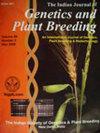应用内含子多态性标记分析芥菜与芸苔属植物的亲缘关系及遗传多样性
IF 1
4区 生物学
Q3 PLANT SCIENCES
引用次数: 0
摘要
利用内含子多态性(IP)标记揭示了代表经典U三角中描述的6种栽培芸苔属的26种基因型之间的遗传变异和关系。对125个拟南芥衍生的IP标记进行了分析,并在6个芸苔属物种中观察到90%至100%的交叉转移性,这表明IP标记在不同芸苔属品种的进化过程中是高度保守的。在每个基因座的物种中观察到的等位基因数量从1个到10个不等,每个引物对平均有2.89个等位基因,在二倍体和四倍体物种中扩增的等位突变数量之间没有一致性。扩增的等位基因大小范围为120-1250bp,反映了不同等位基因的巨大缺失/插入。在芥菜中,获得了100%的交叉转移性,121个IP标记产生了多态性扩增子,PIC值为0.04至0.48。树状图将所有26个基因型分为两组,由甘蓝型油菜/甘蓝型油菜组成。rapa/B。oleracea和B.carinata/B。nigra/B。酒渣鼻。存在于酒渣鼻和甘蓝型油菜中的A基因组。rapa似乎彼此不同,因此通过从不同的Agenome来源重新合成两倍体提供了产生多样性的大好机会。在四倍体物种中,A和B基因组与C基因组相比更相似。不同芸苔属物种之间建立的进化关系将有助于制定合适的育种方法,通过利用二倍体祖先基因库中的遗传多样性来扩大芸苔属双二倍体的遗传基础。本文章由计算机程序翻译,如有差异,请以英文原文为准。
Relationship and genetic diversity analysis of Brassica juncea and U tringle species using intron polymorphic markers
Intron Polymorphism (IP) markers were used to unravel the genetic variation and relationship among 26 genotypes representing six cultivated Brassica species described in the classical U triangle. One hundred and twenty-five Arabidopsis thaliana-derived IP markers were assayed and 90 to 100% cross-transferability was observed in the six Brassica species suggesting that IP markers were highly conserved during the evolution of different Brassica species. The number of alleles observed in species at each locus ranged from one to ten with an average of 2.89 alleles per primer pair and there was no consensus between the number of alleles amplified in diploid and tetraploid species. The size range of amplified alleles was 120-1250bp, which reflects enormous deletions/insertions in different alleles. In B. juncea, 100% cross-transferability had been obtained and 121 IP markers resulted in polymorphic amplicons with PIC value of 0.04 to 0.48. The dendrogram divided all the 26 genotypes into two groups composed of B. napus/B. rapa/B. oleracea and B. carinata/B. nigra/B. juncea. A-genome present in B. juncea and B. napus/B. rapa seems distinct from each other and hence provides a great opportunity for generating diversity through resynthesizing amphidiploids from different available sources of Agenome. The A and B genomes are more similar in comparison to C genome in tetra-diploid species.The evolutionary relationship established between various Brassica species would support in formulating suitable breeding approaches for widening the genetic base of Brassica amphidiploids by exploiting the genetic diversity found in diploid progenitor gene pools.
求助全文
通过发布文献求助,成功后即可免费获取论文全文。
去求助
来源期刊

Indian Journal of Genetics and Plant Breeding
PLANT SCIENCES-
CiteScore
1.80
自引率
10.00%
发文量
0
审稿时长
6-12 weeks
期刊介绍:
Advance the cause of genetics and plant breeding and to encourage and promote study and research in these disciplines in the service of agriculture; to disseminate the knowledge of genetics and plant breeding; provide facilities for association and conference among students of genetics and plant breeding and for encouragement of close relationship between them and those in the related sciences; advocate policies in the interest of the nation in the field of genetics and plant breeding, and facilitate international cooperation in the field of genetics and plant breeding.
 求助内容:
求助内容: 应助结果提醒方式:
应助结果提醒方式:


